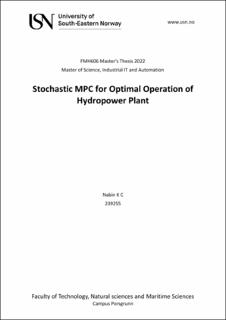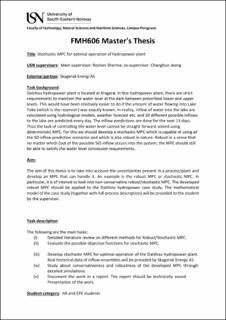| dc.description.abstract | Different categories of industries, such as manufacturing plants, power production plants etcetera, are equipped with a control mechanism to keep their process-variables of interest within the desired limit. Among different prevalent advanced control systems, Model Predictive Controller (MPC) has gained significant interest because of its ability to act based on the uncertainties that may occur in the future.
Skagerak Energi has predicted ensemble of inflow uncertainties that may occur in Lake Toke. The spreading of these ensembles increases as the prediction days march forward. The main goal of this thesis is to design a stochastic MPC (SMPC) that can handle these inflow uncertainties, while maintaining the optimal operation of the hydropower plant by maximizing the reservoir’s water level within the limits.
This thesis starts with an understanding of possible methods for SMPC formulation, such as multistage nonlinear MPC (NMPC), multi-objective optimization (MOO), and Min-Max MPC. Such stochastic formulations are computationally demanding, therefore efficient numerical methods for solving these formulations are often sought out. In this thesis, the direct multiple shooting method is explored as a numerical scheme. The thesis proceeds further with comparison of two different types of objective functions based on the results from deterministic MPC. The objective function which meets the requirement of optimal operation of the hydropower plant is then selected to design the SMPC. SMPC based on the weighted sum MOO is designed. When full spreading of the inflow ensembles was used, the results obtained for the gate opening signals are changing irregularly along with the level constraint violation. However, the results were improved when the inflow ensembles spreading was limited to 100 m3/s. From the author’s experience with the problem, two important factors are outlined for improving the results. First, the spreading of the inflow ensembles should be handled for the outliers, and second, a suitable choice of weighting parameters should be taken into consideration. | |

